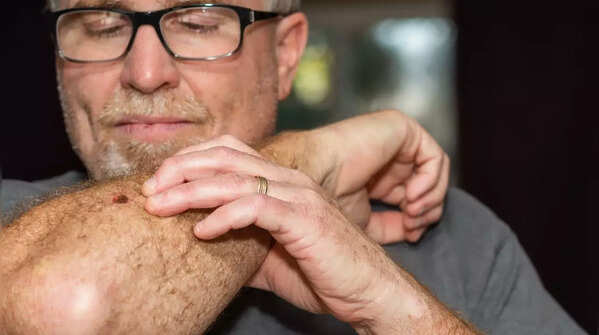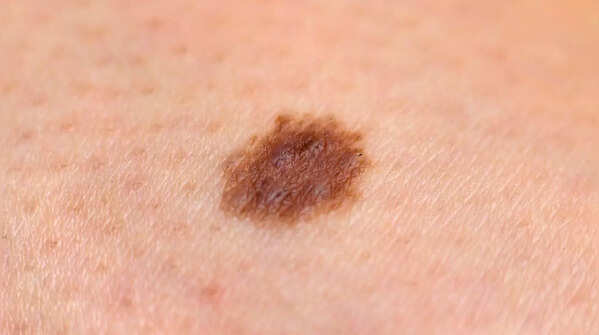Skin cancer is a prevalent global concern, often manifesting subtly through new moles or minor skin alterations that can easily go unnoticed. Early detection is paramount, as it significantly improves the chances of successful treatment. Recognizing potentially cancerous spots is a crucial skill. Be alert for new growths, unusual moles, or persistent sores. Here's a guide to help you identify early signs of skin cancer and understand when to seek professional medical advice.

The ABCDE method is a valuable tool for detecting melanoma, a serious form of skin cancer. Each letter represents a characteristic to watch for:
Any mole exhibiting these features warrants immediate evaluation by a dermatologist.

Persistent skin sores or scabs that repeatedly heal and reappear, or sores that simply refuse to heal, can be an early indicator of basal or squamous cell carcinoma. These sores often present as pink, red, or slightly scaly patches and may bleed or ooze. It's crucial to consult a doctor if a sore persists for more than three weeks or recurs in the same location. Pay particular attention to wounds or sores on the face, arms, or scalp, as these could be subtle signs of skin cancer.

Moles are typically painless and stable. However, a mole that begins to itch, becomes tender, bleeds, or develops a crust should be carefully examined. These symptoms can indicate inflammation or structural changes within the skin, potentially signaling a more serious issue than a typical mole. Consulting a skin specialist is always advisable when such changes occur.

Skin cancers can arise from new growths rather than existing moles. Be vigilant for small lumps, shiny bumps, or rough patches on the skin, especially in sun-exposed areas. Prompt evaluation by a skin specialist is crucial if you observe any such new formations.

If the color of a mole unexpectedly changes or spreads to the surrounding skin, or if the mole develops fading edges, it could be a sign of melanoma. This irregular pigment spread suggests potential growth deeper or wider, requiring immediate attention. Regularly compare your moles over time, and consider taking photos to track any changes that might indicate skin cancer. Dermatological consultation is essential if you notice similar symptoms.

Newer articles
Older articles
 Indian Astronaut Joins ISS: Shukla's Mission Ushers in New Era for India's Space Program
Indian Astronaut Joins ISS: Shukla's Mission Ushers in New Era for India's Space Program
 Ashada Gupt Navratri 2025: Unveiling Dates, Sacred Rituals & Hidden Significance
Ashada Gupt Navratri 2025: Unveiling Dates, Sacred Rituals & Hidden Significance
 Rishabh Pant's Unconventional Batting Redefining Cricket, Says Greg Chappell
Rishabh Pant's Unconventional Batting Redefining Cricket, Says Greg Chappell
 Moto G54 Price Slashed in India: Check Out the New, Lower Cost
Moto G54 Price Slashed in India: Check Out the New, Lower Cost
 JPG to PDF: A Graphic Designer's Guide to File Conversion and Quality Preservation
JPG to PDF: A Graphic Designer's Guide to File Conversion and Quality Preservation
 'The Traitors' Star Apoorva Mukhija Accuses Sudhanshu Pandey of Misogyny and Verbal Abuse After On-Screen Drama
'The Traitors' Star Apoorva Mukhija Accuses Sudhanshu Pandey of Misogyny and Verbal Abuse After On-Screen Drama
 Van der Dussen to Captain South Africa in T20I Tri-Series Against New Zealand and Zimbabwe
Van der Dussen to Captain South Africa in T20I Tri-Series Against New Zealand and Zimbabwe
 20 Minutes to a Healthier Brain and Heart: Neurologist's Simple Strategies to Combat Cholesterol, Blood Pressure, and Dementia Risk
20 Minutes to a Healthier Brain and Heart: Neurologist's Simple Strategies to Combat Cholesterol, Blood Pressure, and Dementia Risk
 England's Audacious Batters Claim They Could Have Chased Down 450 in First Test Win Over India
England's Audacious Batters Claim They Could Have Chased Down 450 in First Test Win Over India
 Popular Finance YouTuber "financewithsharan" Hacked: Security Measures to Protect Your Account
Popular Finance YouTuber "financewithsharan" Hacked: Security Measures to Protect Your Account